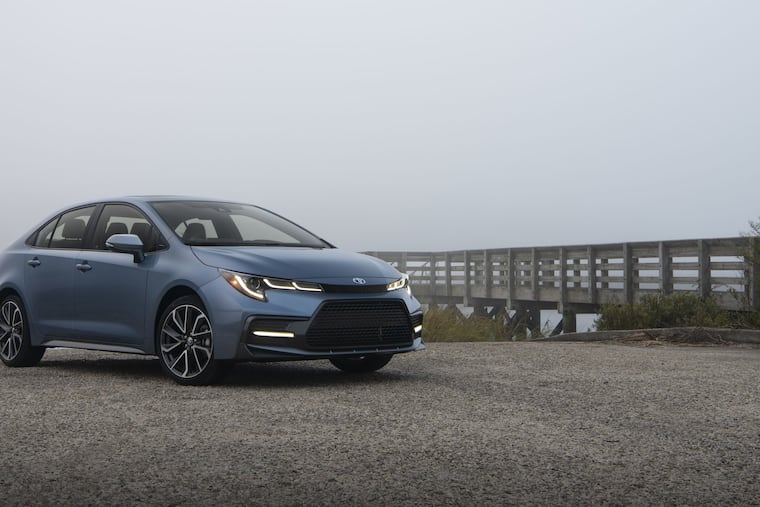Toyota Corolla XSE: When mundane small cars liven up, Part 1
Remember the Corolla? It's a boring, small sedan, right? Look again. For 2020, the little nameplate from Toyota gets bigger, better, and in XSE form, a whole lot more enjoyable.

2020 Toyota Corolla XSE vs. 2020 Nissan Versa SV: Great things, small packages.
This week: Toyota Corolla.
Price: $29,189 as tested. Adaptive front light system, $450; Carpet Mat Package, $249; paint protection film, $395. One big option package noted below.
Conventional wisdom: Motor Trend trumpets, “Corolla XSE is the best Corolla yet — autonomy on the cheap.”
Marketer’s pitch: “Greater than ever.”
Reality: If a Corolla is this nice to drive, you won’t need Mr. Driver’s Seat much longer.
What’s new: Toyota’s basic transportation model gets a significant upgrade across the lineup for 2020, but much of the excitement comes from the XSE form.
So what is new? New design, new platform,Toyota Safety Sense 2.0, and a hybrid Corolla is available for the first time.
Up to speed: Vroom! I think I’m safe in saying I’ve never used that word in a Corolla column, and I certainly never expected to. The 2.0-liter four-cylinder creates 169 horsepower and takes the not-so-little sedan to 60 mph in 8.2 seconds, according to Motor Trend.
Shiftless: Even the Toyota CVT can’t sap the power from this baby. Whether in automatic mode or “shift,” with Sport mode activated or not, the Corolla just gets on out there and does its thing, from a stop or when passing.
A six-speed manual remains a possibility in SE trim, which includes the more powerful engine and some decent options.
On the road: And the speed comes with agility as well. The Corolla XSE is distinctly un-Corollalike on winding country roads, and turns have never been this fun in practically any Toyota before (although I haven’t tested the new Supra, but that’s really a BMW, and the Yaris iA is a Mazda). Sport mode makes this nicer, but standard mode is not Toyota’s usual level of wobbly either.
For comparison, back in 2012, I called that year’s Corolla even more boring than an old shoe.
The Corolla also is a fine companion on the highways. The once-tiny sedan has grown up and comfortably cruises I-95 with the big boys, gliding over the largest of road seams with ease.
Much of this is probably a function of the XSE trim, which offers racer-like 40 series tires, guaranteed to get you nowhere in the snow. And while the ride was smooth, those tires are low-profile enough that I’d worry about big holes shredding them.
Driver’s Seat: Adding to the smooth ride is the smooth interior. The cockpit features dash pieces that borrow heavily from the Camry redesign, and the graphics and stereo interface look inviting and upscale.
The seat offers comfort and support, with snug bolsters that hold one in place and nice-enough materials covering it. Even the Lovely Mrs. Passenger Seat commented on the seat on her side.
Friends and stuff: Alas, nothing is perfect, and we learned about the Corolla’s limits when we sat Sturgis Kids 3.0 and 4.0 in back. You all know the Ballad of 4.0, who’s so tall that he makes some basketball players look short. He doesn’t fit in much of anything these days.
But when 5-foot-3 Sturgis Kid 3.0 complains about legroom and headroom, you’ve built yourself a bit of a problem. The roof sits that low and the rear seat that high.
Cargo space is 13.1 cubic feet.
Play some tunes: The premium stereo ($1,715) offers great operation. Buttons on either side make getting from function to function easy. The touchscreen is used for most of the other functions, and it’s clear and easy to follow as well. Knobs control volume and tuning, but they’re kind of shallow, so occasionally I would graze the touchscreen and find myself somewhere weird.
The sound from the unit is clear and crisp, without the tinkly treble of many Toyota models. But the range remains a little limited, so I’d call this a B+ at best, maybe sneaking into A- territory.
Keeping warm and cool: Another cheap-car problem — the Corolla didn’t offer dual heating controls. So one knob in the tester controlled temperature and the other fan speed, and I kept reaching for them when I wanted radio controls. But this is certainly a step up from some of Toyota’s previous ideas — I’m looking at you, my 2011 Sienna — although the buttons for the rest of the options were small and fussy.
The seat heater controls sat flat on the console right in front of the phone charger, so I often felt a little warm after moving my phone around.
Fuel economy: In the final bonus, the Corolla offers all this fun for its usual brilliant mpgs, which in my tester averaged a little over 35. Feed the Corolla whatever.
Where it’s built: Aichi, Japan.
How it’s built: Consumer Reports predicts its reliability to be a 5 out of 5, where it has been for the last 10 years, except for 2019 (3 out of 5).
In the end: It’s roomier (except in back), it’s fun, and it gets great mpg without the complexity of a hybrid.
Next week: An even bigger surprise from the 2020 Nissan Versa.